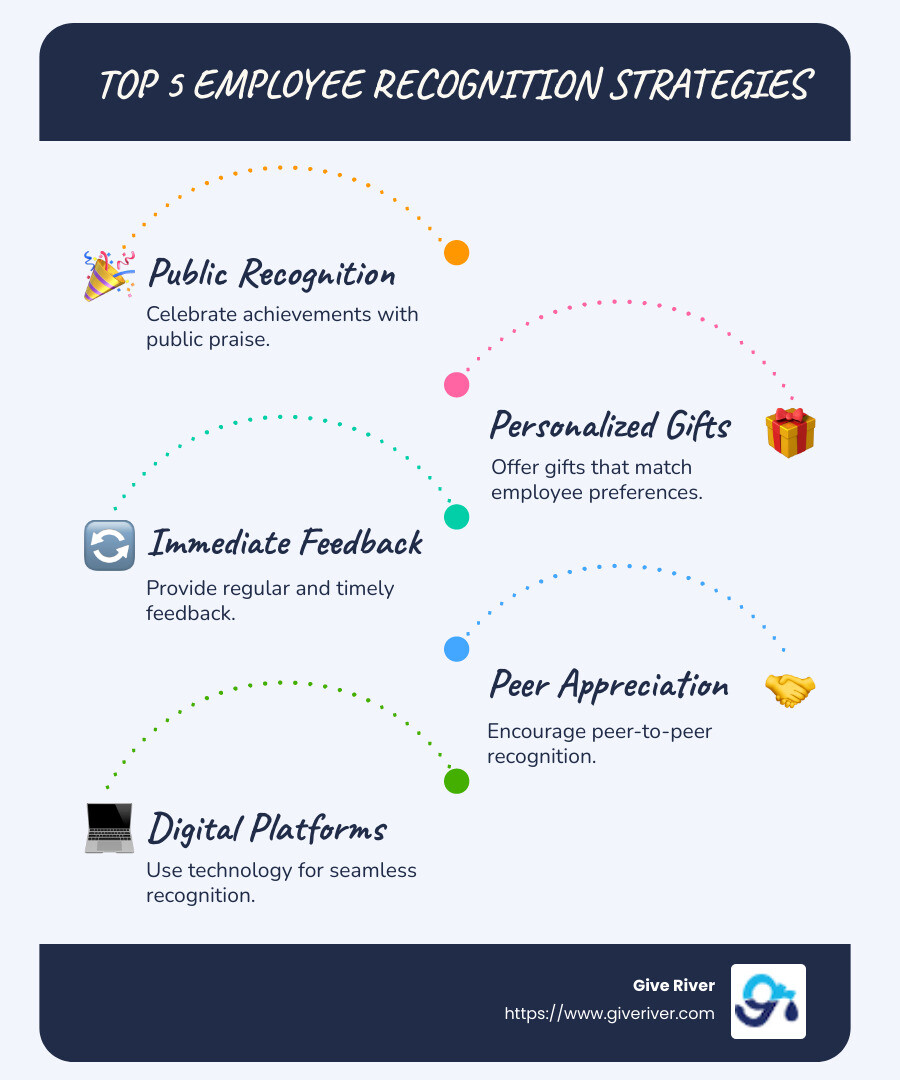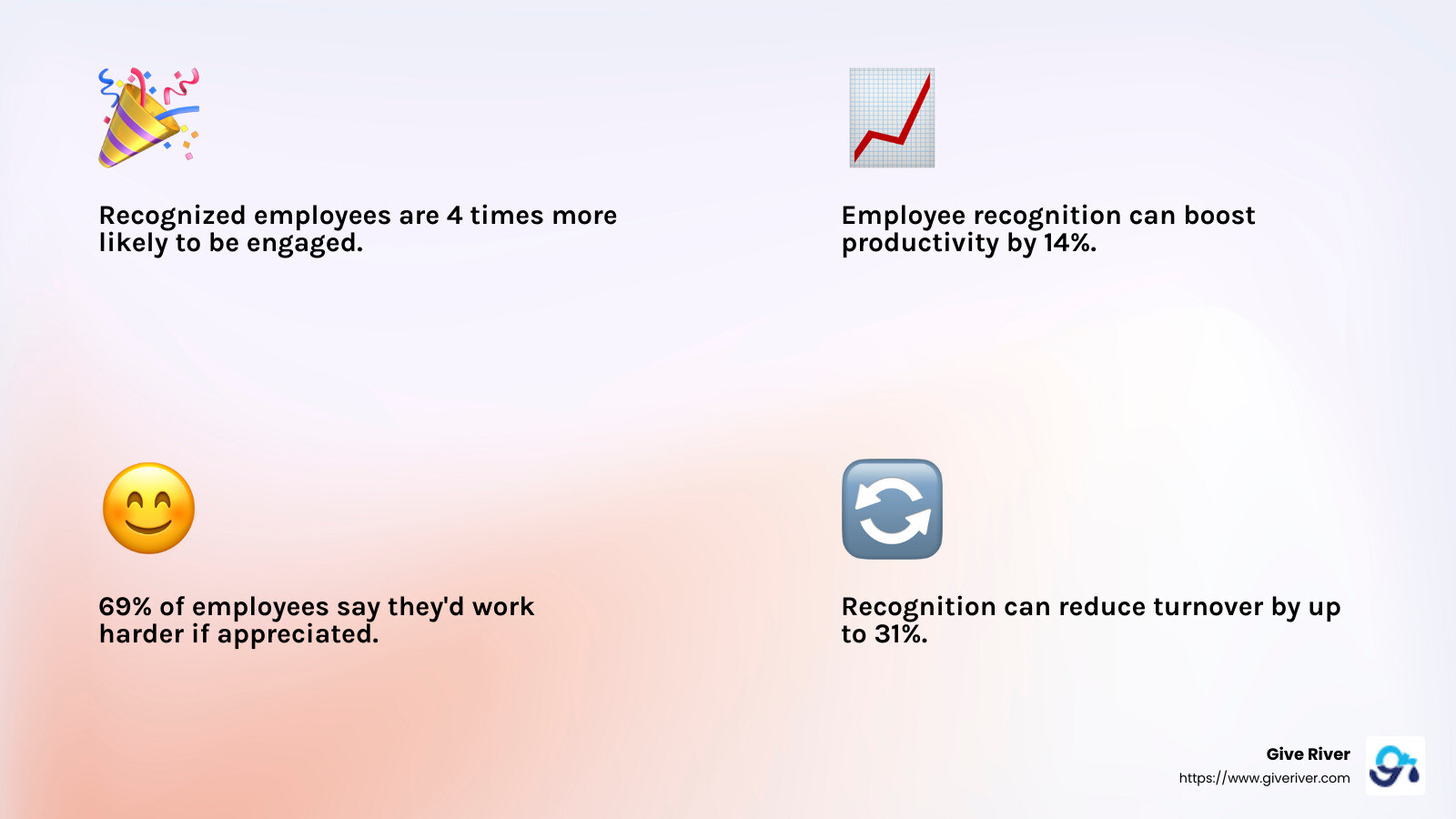33 Effective Employee Recognition Strategies for a Happier Workforce
Discover 33 effective employee recognition strategies to boost engagement and workplace culture for a happier workforce today!

Employee recognition strategies are the key to open uping a thriving workplace culture, driving improved employee engagement, and reducing turnover rates. Here’s a quick rundown of effective strategies:
- Celebrate achievements with public recognition.
- Offer personalized gifts and experiences.
- Implement regular and immediate feedback loops.
- Encourage peer-to-peer appreciation.
- Use digital recognition platforms for seamless integration.
Employee recognition goes beyond mere words; it's about creating an environment where employees feel truly valued and motivated. According to research, organizations that prioritize employee recognition see substantial boosts in morale, productivity, and even profitability. Acknowledging the unique contributions of each team member fosters a sense of belonging and pride. In today’s competitive job market, where talented professionals have many choices, being an employer of choice hinges on effective recognition practices.
I'm Meghan Calhoun, co-founder of Give River, with over two decades of experience in creating meaningful and joyful workplace environments. My journey has taught me invaluable lessons about effective employee recognition strategies. Let's explore how these strategies can revolutionize your HR approach.

Understanding Employee Recognition
Employee recognition is more than just a pat on the back. It's a structured approach to acknowledging employees' contributions and achievements. In simple terms, it means letting employees know their hard work is noticed and appreciated.
Why is employee recognition important? It creates a positive work culture where employees feel valued. This leads to a happier, more engaged workforce. When employees feel appreciated, they are more likely to stay with the company, reducing turnover and boosting productivity.

Benefits of Employee Recognition
Increased Motivation: Employees who feel recognized are more motivated to maintain or even improve their performance.
Higher Job Satisfaction: Recognition leads to higher job satisfaction, which can translate into better customer service and increased profits.
Improved Retention Rates: When employees feel valued, they are less likely to leave, saving the company costs associated with hiring and training new staff.
Improved Teamwork: Recognizing collective achievements fosters teamwork and collaboration, as employees work together towards common goals.
Boosted Morale: Regular acknowledgment of efforts can lift spirits and create a positive atmosphere, making the workplace a more enjoyable place to be.
Employee recognition strategies are essential tools for cultivating a thriving workplace. They help employees feel appreciated and can significantly impact an organization's success. By implementing these strategies, companies can create an environment where employees are motivated, engaged, and ready to contribute to the organization's goals.
33 Effective Employee Recognition Strategies
Regular and Immediate Feedback
Timely recognition is crucial. When employees do something great, acknowledge it right away. This immediate feedback reinforces positive behavior and ensures the recognition feels genuine. Specific feedback is also key. Instead of saying "Good job," say "Great work on the project presentation. Your analysis was spot-on and really impressed the client."
Public and Private Praise
Some employees thrive on public recognition, while others prefer private appreciation. Public praise can be as simple as a shoutout during a team meeting or a post on the company's internal platform. For those who prefer a quieter acknowledgment, a personal thank-you note or a one-on-one conversation can be more meaningful.
Value-Based Awards
Align recognition with your company values. Create awards that reflect these values and celebrate employees who embody them. For example, a "Teamwork Award" for someone who consistently supports their colleagues. This not only rewards individuals but also reinforces the values you want the whole team to accept.
Experiential Rewards
Experiential rewards offer unique experiences that employees will remember. Instead of a generic gift card, consider offering options like a cooking class, concert tickets, or a weekend getaway. These experiences can create lasting memories and demonstrate appreciation in a personal way.
Peer-to-Peer Recognition
Encourage peer recognition to build stronger bonds within the team. When colleagues recognize each other's efforts, it fosters a sense of camaraderie and teamwork. This can be done through a simple nomination system or a dedicated platform where employees can publicly acknowledge their peers' contributions.
Personalized Gifts
Customized gifts show that you know and appreciate your employees as individuals. Consider their preferences and interests when selecting a gift. Whether it's a personalized mug, a book by their favorite author, or a subscription to a service they love, these thoughtful gestures can make a big impact.
Social Media Shoutouts
Use social media to give public acknowledgment to employees. A shoutout on the company's LinkedIn or Twitter page can highlight their achievements and make them feel valued. It's also a great way to showcase your company's appreciation culture to a wider audience.
Wellness and Flexibility
Promote employee wellness by offering flexible work options and wellness programs. Recognize employees who prioritize their well-being and encourage others to do the same. This not only shows that you care about their health but also helps maintain a happy and productive workforce.
Celebrating Milestones
Celebrate work anniversaries and other significant achievements. These milestones are important markers in an employee's career journey. Acknowledge them with a small gift, a personalized note, or a team celebration to show appreciation for their dedication and hard work.
Gamification and Fun
Incorporate gamification and fun activities into your recognition strategy. Create friendly competitions or challenges that reward employees for reaching goals or demonstrating company values. This not only motivates employees but also makes the workplace more enjoyable.
Community Impact
Encourage volunteer days and support community service initiatives. Recognize employees who actively participate in these activities. This not only benefits the community but also improves the company's reputation and fosters a sense of pride among employees.
Recognition Software
Use recognition platforms and digital tools to streamline your recognition efforts. These platforms make it easy to give and receive recognition, track achievements, and ensure that no effort goes unnoticed. They also provide valuable data to help improve your recognition strategies over time.
By integrating these employee recognition strategies into your workplace culture, you can create a more engaged and motivated workforce. Recognizing employees in meaningful ways not only boosts morale but also drives productivity and loyalty.
Employee Recognition Strategies for Managers
Leadership Involvement
For any employee recognition strategy to succeed, it must start at the top. Leaders who actively engage in recognizing their teams set the tone for the entire organization. When executives and managers model appreciation, it creates a ripple effect across all levels.
A study by Great Place To Work found that managers who ranked in the top 10% for giving recognition had employees who were significantly more engaged. This engagement translated into higher morale and productivity. Managers should regularly and genuinely express gratitude, whether through a simple "thank you" or a more formal acknowledgment.
Manager Training
Managers play a crucial role in nurturing a culture of recognition. However, many may not know how to effectively recognize their employees. Providing manager training on recognition techniques can bridge this gap. Training should focus on:
- The Importance of Recognition: Explain why recognizing employees is essential for motivation and retention.
- How to Recognize: Offer practical tips on giving timely, specific, and meaningful recognition.
- Tools and Platforms: Familiarize managers with any recognition software or tools the company uses.
Training can be delivered through workshops, webinars, or even short, interactive sessions integrated into regular meetings. The goal is to equip managers with the skills and confidence to recognize their teams effectively.
Creating a Recognition Culture
A strong recognition culture is not just about formal programs—it's about making appreciation a natural part of daily interactions. Encourage managers to recognize both big achievements and small, daily wins. This could be as simple as starting meetings with a quick acknowledgment of recent accomplishments.
Managers should also be encouraged to personalize recognition. Understanding individual preferences and tailoring recognition accordingly can make it more impactful. Some employees may appreciate public praise, while others might prefer a private note or conversation.
By fostering a culture where recognition is frequent and genuine, managers can help create a happier and more motivated workforce.
Frequently Asked Questions about Employee Recognition Strategies
What are employee recognition strategies?
Employee recognition strategies are systematic approaches used by organizations to acknowledge and reward employees for their contributions and achievements. These strategies aim to boost morale, increase engagement, and foster a positive workplace culture. Examples include regular feedback, public praise, personalized gifts, and value-based awards.
Recognition strategies can vary widely, from simple verbal acknowledgments to formal awards programs. The key is to ensure that the recognition is meaningful and aligned with the company's values and goals.
How to effectively recognize employees?
To recognize employees effectively, follow these best practices:
Be Timely: Recognition should be given as soon as possible after the achievement. This reinforces the behavior and shows that you are paying attention.
Be Specific: Instead of a generic "good job," specify what the employee did well. For example, "Your detailed analysis in the report helped us identify key trends."
Be Genuine: Ensure that your recognition is sincere and not just a checkbox exercise. Employees can tell when appreciation is authentic.
Use a Mix of Methods: Combine public and private recognition. Some employees appreciate public acknowledgment, while others prefer a private note or conversation.
Leverage Technology: Use recognition platforms to streamline and track recognition efforts. These tools can help ensure consistency and reach remote teams.
What is the best recognition for employees?
The best recognition is impactful and aligns with individual employee preferences. Here are some tips:
Personalization: Tailor recognition to the individual's likes and achievements. Some may value a shoutout in a team meeting, while others may prefer a handwritten note.
Align with Values: Recognize behaviors that reflect company values. This reinforces the importance of these values and encourages others to follow suit.
Celebrate Milestones: Acknowledge work anniversaries, project completions, and personal achievements. Celebrating these moments shows that you value employees' journey and contributions.
Offer Experiential Rewards: Instead of monetary rewards, consider experiences like a day off, workshop enrollment, or a team outing. These create lasting memories and strengthen team bonds.
By understanding what motivates your employees and using a variety of recognition methods, you can create a more engaged and satisfied workforce.
Conclusion
At Give River, we understand that effective employee recognition is more than just a pat on the back. It's about creating a culture where employees feel valued and motivated every day. Our comprehensive approach, centered around the 5G Method, integrates recognition with wellness, growth, gamification, and community impact. This unique strategy not only boosts employee fulfillment but also improves productivity and engagement.
The 5G Method is designed to transform workplaces by focusing on five key areas:
- Recognition: Regularly acknowledging both big achievements and small efforts to foster a culture of appreciation.
- Gamification: Making it fun and something employees want to do, instead of have to do.
- Wellness: Prioritizing employee well-being through bite-sized mini-courses on wellness topics.
- Growth: Providing opportunities for personal and professional development, ensuring employees have the resources they need to succeed.
- Community Impact: Encouraging employees to engage in volunteer work and community service, strengthening their connection to the company and society.
By implementing these strategies, we help organizations build happier, healthier, and high-performing teams. Our platform provides the tools and guidance needed to seamlessly integrate these elements into your workplace culture.
Ready to transform your workplace? Explore how Give River can improve your employee recognition efforts with our comprehensive approach. Let's create a positive and thriving work environment together.




